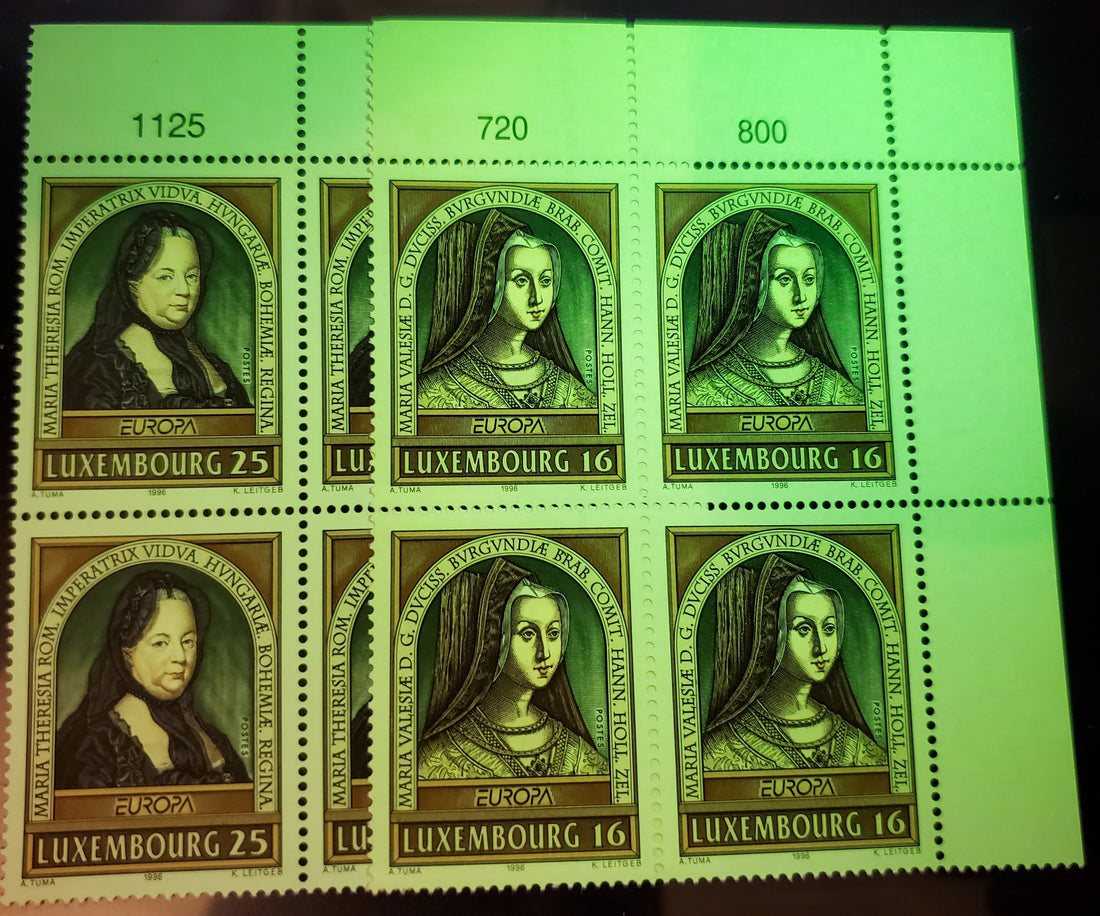The modern issues of Luxembourg form quite an interesting collecting field, because the issues of the country are a conglomeration of issues printed by different countries in Europe, including:
- Switzerland, which supplies most of the issues in the 1950's and 60's and most of the stamps produced purely by photogravure.
- Belgium, which supplies some of the issues printed by photogravure, and some printed by photogravure and engraving.
- Netherlands, which supplies some of the engraved and photogravure issues in the 1950's and 60's.
- France, which supplies most of the engraved multicolour stamps, and
- Austria, which supplies most of the multicoloured stamps printed by photogravure and engraving
What makes collecting this material at a specialized level is that each printer used their own paper, which exhibits its own fluorescent varieties and tagging follows whatever each country was doing at the time. So, you can experience a wide variety of different paper and fluorescent tagging variations.
Paper Types and Fluorescence
Then Swiss issues were printed on a chalky paper, that up until the late 1960's is more or less always NF or dull under UV. Starting in the mid to late 1960's some printings are found on paper containing some fluorescent fibres. This paper can still appear dull, or if there are enough fibres it can appear low fluorescent.
Then, in the 1980's another type of paper appears that contains fibres that glow yellow under UV. The number of fibres is small, with generally fewer than 10 per stamp. Then in the late 1990's another paper makes an appearance, which contains fibres that are hibrite, but glow different colours under UV as seen below:

The Dutch issues printed by Enschede are generally either on DF paper, but can occasionally be found on LF paper, as can some of the photogravure printings.
The French issues show the largest amount of variation, with the earlier issues being DF and then becoming fluorescent in the 1960's to low, medium and high levels, finally reaching hibrite levels in the very late 60's. Most of the French issues I have examined from the 1970's on are all on HB paper, though some must also exist dull.
The Austrian and Belgian printed issues are generally found on low fluorescent to high fluorescent papers and show quite a bit of variation.
Tagging Variations
Starting in the mid 1970's the Swiss produced issues started to be coated with an overall yellow fluorescent tagging, as did the Austrian produced issues of the 1980's and the Belgian produced issues of the 1970's. The tagging can show a considerable amount of variation in the strength of the glow, as shown by these two souvenir sheets:

If you compare the appearance of the selvedge at the top, you can see that the sheet on the left appears yellower than the one on the right.
Also, on some issues the tagging contains breaks, as on the pair below, where there is a horizontal break in the tagging.

Here is an example of an Austrian produced issue with overall fluorescent tagging:

Later in the 1990's the Austrians abandoned all over tagging in favour of square tagging around the frame of the stamp, similar to the GT-4 tagging found on Canadian stamps. This tagging has the same yellowish glow.
Shade Variations

Although the earlier engraved stamps show little variation in paper fluorescence, you will find that there are distinct differences in some of the shades of ink used to print the stamps. A good example is the above 4 franc stamps from the 1957 Europa issue.
So, there is my brief rundown of some of the potential ways that you can explore the modern stamps of Luxembourg in greater depth.

